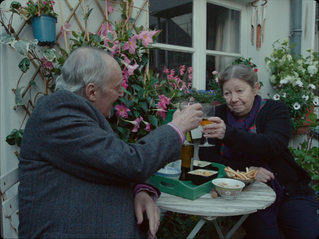Betty Blue
- Jessica Moore

- Feb 5, 2021
- 2 min read
Jean-Jacques Beineix, 1986

Zorg fixes houses. He repairs their damage, seals their cracks. Betty’s swift arrival into his world destabilises this mundanity—she is, for lack of a more autonomous word, a distraction. To stay afloat, and to sustain their languorous bohemian lifestyle together, they fill their days renovating neighbouring shacks by painting them pink and blue; to the inferential promise that by night, they can fall into each other’s arms and into the starry role-play of a writer and his lover, as if there is nobody else on earth. This routine works, for a time. “I’ll paint the whole town pink just to stay with you, kitten” Zorg pleads to Betty, who quickly grows tired of labouring. Seeking an alternative, and in the most literal allegory one could imagine, Betty sets their decrepit little home ablaze, forcing relocation.

“See the wind outside, blowing bits of newspaper by? Papers from the North one day, the South the next, always the same bullshit and we’re in between.” This liminality, though its precise materialisations flit between hotels, cars, an apartment above a piano store—none of which Betty and Zorg own—seems an appropriate lens through which to view Beineix’s film: as a meditation on existing spatially and emotionally in-between.
Betty is famously described by critics as a ‘sexually aggressive spirit’, a figure of ‘unbalanced sanity’, and while those descriptors are in many ways accurate, they disrupt the film’s devotion to Betty, no matter how destructive this devotion may be. Aligned with Zorg’s adoration, one absolutely restricted by his blind infatuation, the film is all for her—each dolly shot caresses her, the sunburnt landscape tumbles in harmony with her estrangement. Thus in order to challenge the lustre of her characterisation, especially the now outdated portrayal of undiagnosed mental illnesses, one must consider the slippage between Betty and the world around her—a world described as “too small.”
This slippage manifests cyclically, Betty’s life a revolving force of destruction, one which accelerates with each revolution. Visualised by the ghostly carousels that continuously, surreally crop up in different locations, immobility consumes the narrative. Always moving yet unable to move forward, bodies collapse inward—feelings reside in flesh.
Beyond its categorisation as a figurehead of cinéma du look, a style-over-substance movement which saw a collective of French films centre alienated young couples, Betty Blue illustrates the unsustainability of disharmony; the suffering in failing to understand those around you, no matter how synchronous or loving those connections appear. The chasm between Zorg and Betty was always there, swelling beneath a patina of sexual freedom. As an image Zorg pours over, a figure he longs to repair, Betty is a lithograph, a tragic and rebellious etching into the art of placelessness—a sad flower in the sand.*

*John Fante, Ask the Dust








Comments